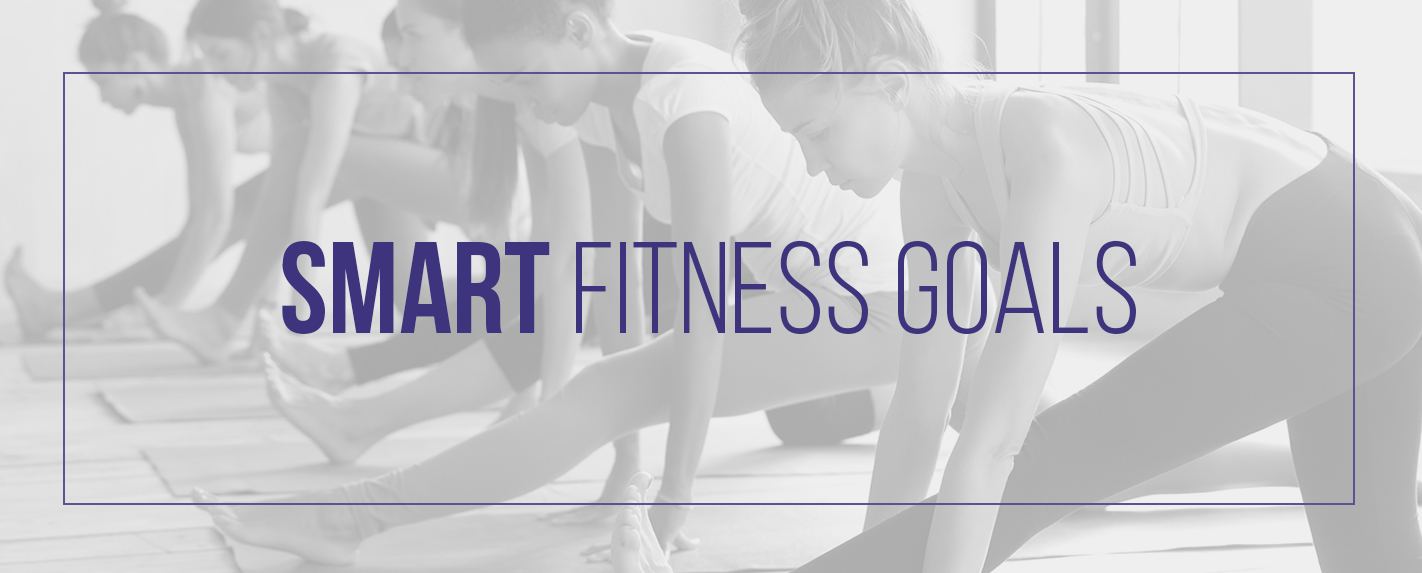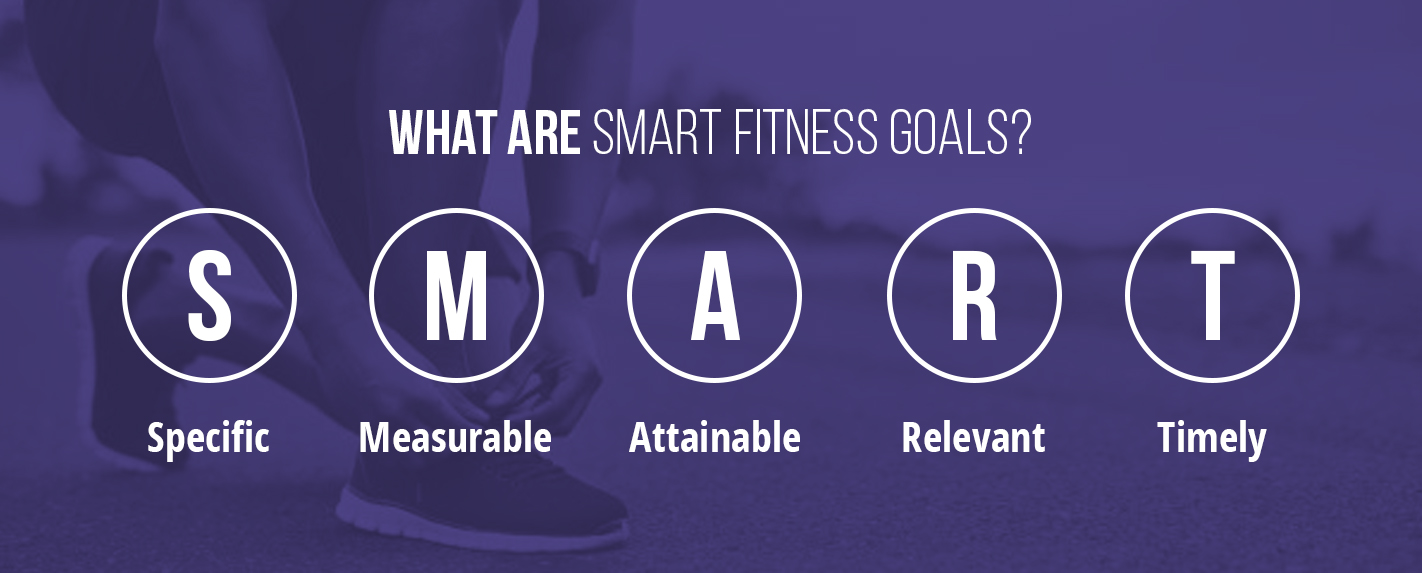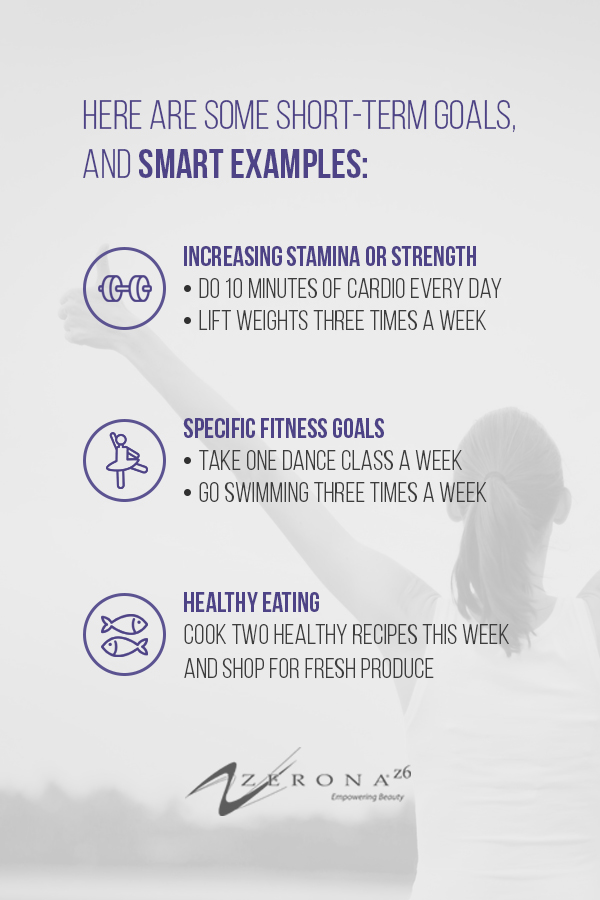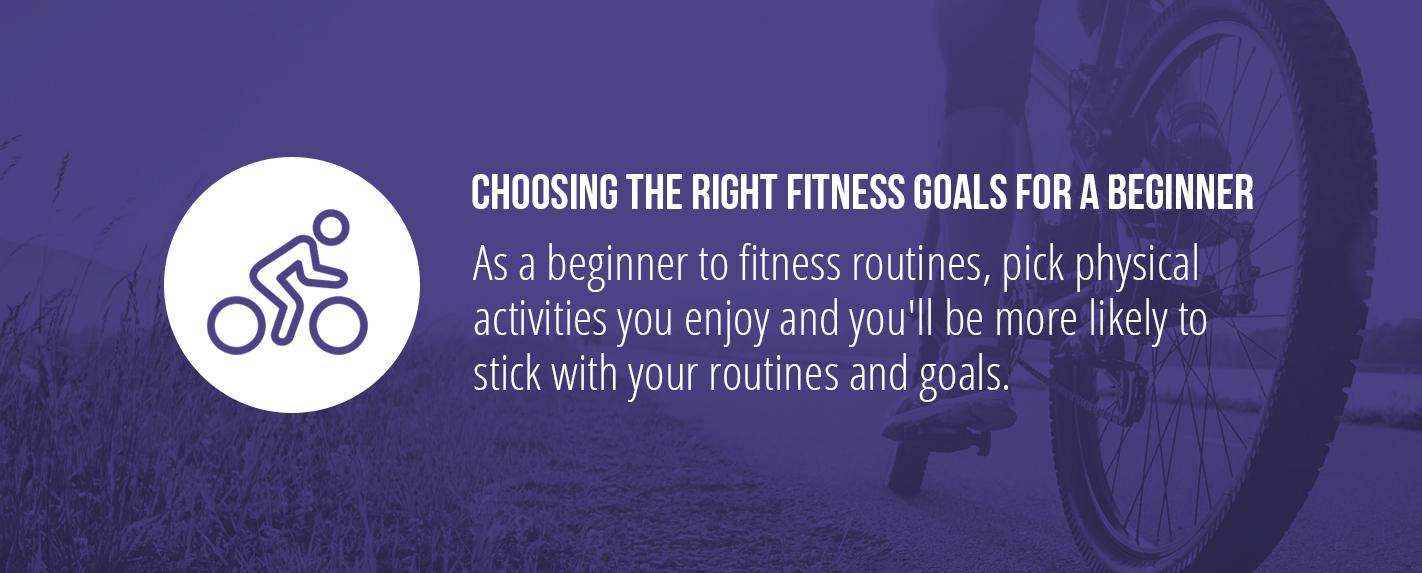
Goal setting seems to be a part of human nature. We set goals for everything — from relationships to work to health and fitness. Setting goals can help us stay on track for our accomplishments, and keep our lives and priorities organized.
However, we often make vague goals without specific information about how the goal will be attained. These vague goals, because they are often large and encompass several steps to complete, often can feel daunting and go unaccomplished because they lack specificity and planning. Using SMART goals, especially for your health and fitness well-being, can help get past this and lead to greater rates of success.

What Are SMART Fitness Goals?
SMART goal setting brings structure and accountability to your plans, making them more effective. SMART stands for an easy-to-remember acronym — Specific, Measurable, Attainable, Relevant, and Timely – that will help you set distinct goals.
Specific
The S in SMART goals is for specific, and encourages us to move away from general, ambiguous goal planning to more clearly defined, direct goals that are easy to understand. Setting goals such as “I want to be fit” or “I want to be healthier” are too general and vague to carry through successfully. While they are good goals to have, they lack a clear focus and an endpoint. Think about exactly what you want to attain and how you will get there. Goals like “I want to lose 10 pounds” or “I want to be able to run a 5k” are much more specific. You can set up clear steps that will lead to achieving your goal, and you’ll know when you accomplish them.
Measurable
M is for measurable, and involves tracking your progress, as well as adding specific numbers to your goal. It’s difficult to measure goals regarding increased happiness or health, but goals surrounding a specific number of pounds to shed or miles walked have a measurable quality you can track. Other examples of quantifiable goals are to “walk 10,000 steps every day” or “go to the gym three times a week” — specific goals that are easily measurable. Knowing when you’ve hit a goal means you can celebrate your success. The sense of accomplishment you feel will keep you motivated to tackle other goals. Reward yourself when you achieve it, and then set a new goal!
Attainable
A is for attainable, and means that your goals should be realistic and achievable. Make sure your goals make sense and are not too extreme. For example, saying that you want to lose 10 pounds in one week is likely an unattainable goal. Most people can lose about 1-2 pounds per week. If you say you want to lose two pounds in one week, this is a more realistic goal post for you to stretch and achieve, and feel a sense of accomplishment when you do.
It’s also important to challenge yourself, as goals that are too easy aren’t motivating either. Attainable also can involve breaking up larger long-term goals into more manageable short-term steps. Want to run a marathon but have never been a runner? Setting a smaller goal, like being able to run one mile, is much more attainable, and keeps you in line with your longer-term goal. Attainable goals are action-oriented, with clearly defined steps that outline the path to success.
Relevant
R is for relevant, and it means your goals should make sense to you at this time in your life, and be motivating enough that you want to achieve them. Don’t set a goal to run a marathon just because it’s trendy or your friend is pressuring you to do it. Set goals for activities that sound enjoyable to you. Relevancy also means choosing goals that make sense to your age, health, fitness levels and what is going on in your life now. Choosing to drop some pounds because a wedding or big event is coming up is a relevant goal based on your current life events. To check for relevancy, ask yourself if there is a why behind your goal and if that reason makes sense in your life right now.
Timely
T is for timely, or time-bound, and this aspect of goal setting is all about the deadline. Does your goal have a specific deadline attached to it? Without a timely deadline, the goal may be continually put off and never achieved. Make sure your deadlines are challenging enough, but also realistic and doable. This accountability will keep you motivated to keep going. You can set a date for a longer-term goal, along with several check-in dates or deadlines for smaller goals that keep you on track toward the main goal.

Short-Term vs. Long-Term SMART Fitness Goals & Examples
There are so many ways to improve your health and fitness. Long-term fitness goals are the big-picture end goals you hope to accomplish through your various short-term goals. If you’re still not sure what kind of goals to set, check out these categories of long-term goals with examples:
- Keeping a workout regimen. Improving your workout schedule — or starting one — is a great long-term fitness goal. Make it SMART by including specific details, such as how often you want to work out, when, and where, and tailor it to your abilities. Examples of this type of goal could be “work out at the gym three times a week before work” or “take a walk every day after dinner.”
- Losing weight. Perhaps one of the most popular goals, losing weight is usually a long-term goal, but can be broken up into smaller short-term steps too. It’s also easily customizable to your individual needs and abilities. Set a SMART goal like “lose 50 pounds” or “lose 10 pounds in two months” and lay out the diet and exercise plans that will help you reach that goal.
- Healthy living. Maybe you simply want to eat healthier, or you have a specific health-related goal in mind, such as lowering cholesterol or blood pressure levels or easing stress. Long-term goals in this category could include “lower my cholesterol levels by the end of the year” or “practice mindful meditation daily.” Examples related to healthier eating could be “participate in meatless Mondays every week” or “eat less processed food and more fresh, whole foods.” These goals ultimately promote overall health, and can easily be broken down into actionable steps that serve as short-term goals.
- Big fitness goals. These lifetime goals are for those who dream of running a marathon, climbing a mountain or competing in another sporting event. Set these big-picture goals like “compete in an ironman competition” or “participate in a 150-mile biking fundraiser” and then prepare to break down the steps and short-term goals that will help to train you for these bigger events and goals.
Short-term goals are great for providing those smaller steps on the way towards a bigger goal while providing you with smaller accomplishments to celebrate and motivate you to keep going. They can also stand alone as fitness goals that are easier to attain. Here are some short-term goals, and SMART examples:
- Increasing stamina or strength. Start small by setting manageable goals like “10 minutes of cardio every day” or “lift weights three times a week.” Once you get in a good routine with these goals, make small increases like changing your goal to “15 minutes of cardio of every day” and adjust for what is personally attainable for you.
- Specific fitness goals. Are you interested in something specific like running, swimming or dancing? Set a short-term goal related to your interests. It could be “take one dance class a week” or “go swimming three times a week.” It could also involve specific target areas of the body. For example, if you’re looking to tone the tummy, your SMART goal could be to “do 50 crunches every day.”
- Healthy eating. While you may have a long-term goal of eating healthier in general, SMART short-term goals could include “cook two healthy recipes this week and shop for fresh produce” or “bring lunches from home instead of buying takeout all week.” When you accomplish these shorter goals, set another for next week.

Choosing the Right Fitness Goals for a Beginner
If you’re just starting your journey to better health and fitness, the varied advice and choices can seem daunting to sort through. If you are unsure where to start, pick something small. Keep your goal simple, and give yourself ample time to accomplish your goal.
It may help clarify your goals to ask yourself why you are adding fitness to your life now, how your life will be different with your new routine — or your new results — and how you will implement these routines into your life. These questions can get to the bottom of what you want to accomplish and what goals are going to help you.A walking program is a great starting point for fitness beginners. Start with a goal to go for a short walk five times a week. As you get in the habit, start increasing the length of your walks in small increments. Walking is a great introduction to getting fit and losing weight, all while exploring your neighborhood or experiencing nature at the same time.Some other beginner goals to start with:
- Take the stairs an extra time every day
- Use a pedometer or smart fitness tracker and keep track of steps
- Plan and complete a workout or fitness class
- Do something physically active every day
- Drink more water every day
- Limit processed foods and prepare fresh meals at home
Whatever goals you choose to start with, make sure that they are doable at this point in your life, and that you can keep them up. Instead of trying to fit in multiple high-intensity workouts, work on incorporating small sessions of fitness into your daily or weekly routine. Trying to do workout routines that are much too difficult only leads to burnout or giving up, so focus on making a routine of workouts you can complete.
As a beginner to fitness routines, pick physical activities you enjoy and you’ll be more likely to stick with your routines and goals. If you don’t enjoy going to a gym, find a class or group for something that you do like. There are all kinds of options out there from rowing to salsa dance to kickboxing that will infuse more fun into your workouts. Or consider being more active at home with gardening, yard work, housework or playing with the kids. These activities are all great ways to sneak in more physical activity to your normal routine.
Other Things to Consider in Addition to a Fitness Routine
When you are creating your fitness goals, incorporating other healthy habits can help you feel and look your best and give you more energy and motivation for your workouts. Diet and exercise go hand-in-hand, so adding a plan for healthy eating to your fitness goal can help you achieve it faster. Having a plan in place for healthy eating will keep you on track and accountable too. Be specific with your healthy eating goals — do you want to cut calories, eat more fresh produce or eat takeout less? Pick a healthy eating goal that makes sense to you and add it to your fitness goal.
Two other important considerations that can help keep your fitness plan on track are good sleep and healthier stress levels. Both stress and a lack of sleep lead to lower energy and overeating. If these tend to be problem areas for you, address them in your fitness plan so you can keep on track. Incorporate meditation or another stress-relieving activity into your daily routine, and make a plan for a better night’s sleep. This plan could involve going to bed earlier, having a better bedtime routine or making your bed and bedroom more comfortable and relaxing.You should also have room in your plan for fun. If it feels like all you do is work and workout, you may burn out faster or become bored with your fitness routine. Leave room in your goals for recreation and personal hobbies, and you’ll feel more satisfied. Sometimes a workout activity you enjoy can become a hobby too! A well-rounded fitness plan that includes all of these other health considerations will give you your greatest chance of success.
Zerona Is a Great Compliment to Any Fitness Routine
Ask a doctor about Zerona. This non-invasive cosmetic procedure uses lasers to emulsify fat cells and target your body’s problem areas. There’s no downtime and none of the unpleasant side effects of surgical procedures, so you can easily use Zerona treatments in conjunction with your other fitness and healthy eating routines. Zerona is offered by providers around the world. Find a provider near you today to set up your appointment.
Last Updated on December 19, 2019 by zerona

